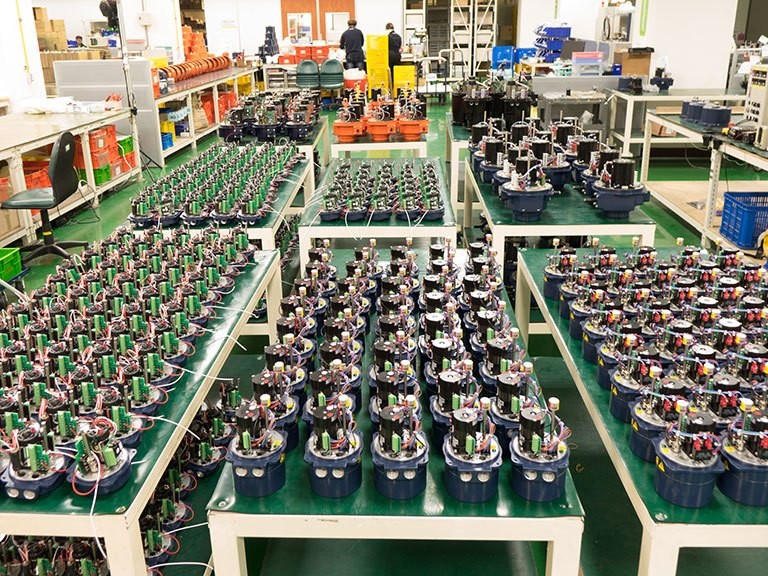Centralized control of a plant involves the control of its services such as water, steam, air, fuel, electricity, etc. Of these, all except electricity involve piping, and their control involves valves, which are usually power operated.
Where distances are greater than about 100 metres, the remote control system which is viable is electricity, because control signals on the alternative fluid systems (pneumatic, hydraulic) are attenuated by pressure drops in the pipes, and slowed down to the pipe speed, so that the cost of control piping for these systems would be astronomical for long distances.
Electric signals are virtually instantaneous and can easily be amplified by relays or electronics to make transmission over long distances economical. It is also impossible for a wire to transmit dirt and moisture, which is inherent in fluid systems.
CHOICE OF POWER SYSTEM
Electric motors and solenoids, pneumatic and hydraulic pistons and motors are all possible choices for valve operation.
Solenoids are limited to short strokes at high speed for two strokes only – on and off and are therefore only relevant for small valves. These solenoid-operated valves are, however, a vital link between electric control systems and fluid power systems, which are therefore only as reliable as the solenoid valves for remote control.
Electric motors have inherently high rotational speed and kinetic energy, and must be geared down to operate valves, the normal speed being 10 - 12 inches per minute. Provided that the gearing is self-locking, a motorized valve stays put in the event of power failure; for the same reason, it virtually uses no power for most of its life, only during the actual change of valve position.
Electricity is not readily stored other than by a DC battery. Alternative methods of stored energy in an electric actuator use a compressed spring.
PNEUMATIC POWER
Given the availability of a plant air supply, a pneumatic cylinder is the cheapest form of muscle power to operate valves. It is easy to regulate speed by restriction and force by pressure. Compressed air is an economical form of power storage for emergency operation; because a piston is not self-locking, it can also be used against a spring for emergency operation in small sizes. There is no kinetic energy to help unseat wedging valves – and therefore no hammer blow effect. The compressibility of air limits its ability to hold a valve position against reaction forces. Distant remote control involves the addition of solenoid valves, with limit switches for remote indication, while standby manual operation becomes expensive as soon as the valve is too big for a simple key operation, because a manual drive must be declutched to permit the piston to move. These additions usually make the cost of a simple pneumatic piston operator greater than the equivalent electric actuator, particularly in hazardous locations. In addition, two systems have to be brought to the valve – electric control and pneumatic power, so that the installation is expensive. Part of the cost of the pneumatic supply and filtration system source must also be taken into account in assessing the comparative costs.
The forces available from pneumatic systems are limited by the commercially available pressures of 60 - 100 p.s.i., so that it is difficult to operate large valves with pistons.
All pneumatic systems have the virtue of being able to vent to atmosphere and therefore require a single run of pipe only. All have the drawback of requiring clean, dry air and this is a problem, particularly in cold weather.
HYDRAULIC SYSTEMS
Hydraulic pistons operate economically at pressures of the order of 2,000 p.s.i., and can therefore provide high forces in small dimensions, and high operating speeds. Hydraulic pressure can be stored in accumulators so that fail-safe operation can be arranged. The incompressibility of liquid provides greater position stability than pneumatic systems, with the ability to apply a hydraulic lock. The fluid must be returned to the reservoir, and this requires a large diameter return pipe to avoid backpressure and consequent loss of power. The piping installation is therefore more expensive than for pneumatic, to which again must be added the cost of electrical remote control and indication and standby manual operation.
A suitable source of hydraulic power (motor, pump, reservoir and accumulator) must be provided adjacent to each group of valves.
CHOICE OF SYSTEM
From the foregoing, it is logical that each system has its merits. Hydraulic operation is inherently the most expensive and is therefore only viable when high forces and/or speeds are required, with the possibility of operation during power failure. For all these the energy storage facility of the accumulator is particularly valuable. It may also be essential where a particularly dangerous spark hazard exists, as in tankers.
Pneumatic systems are economical where plant air is available, valve sizes are relatively small and local operation only is required. It is also usefully utilized where fail-safe operation is required, although this involves the considerable overhead of maintaining an air supply continuously to meet the normal operating requirements of the valve.
Electric motor actuators are the logical choice for intermittent operation of isolating or manual regulating valves, where it is convenient that the valve stays put on loss of power, and where remote electrical control is required. The mechanical inefficiency of the drive limits the frequency of operation, so that for modulating duties, fluid systems are better. The inertia of the motor, while a virtue for unseating valves, also limits the maximum speed available, so that very fast operation may require a fluid system.
POINTS FOR ELECTRICAL MOTORIZED VALVES
- When remote control and standby manual operation is required, the total installed cost of an electric actuator system should be lowest.
- A good electric system is fundamentally more reliable, as it is totally free from the problems of dirt, moisture, and freezing, which affect fluid systems.
- Motorized valves involve no continuously running plant and therefore no plant maintenance routine.

